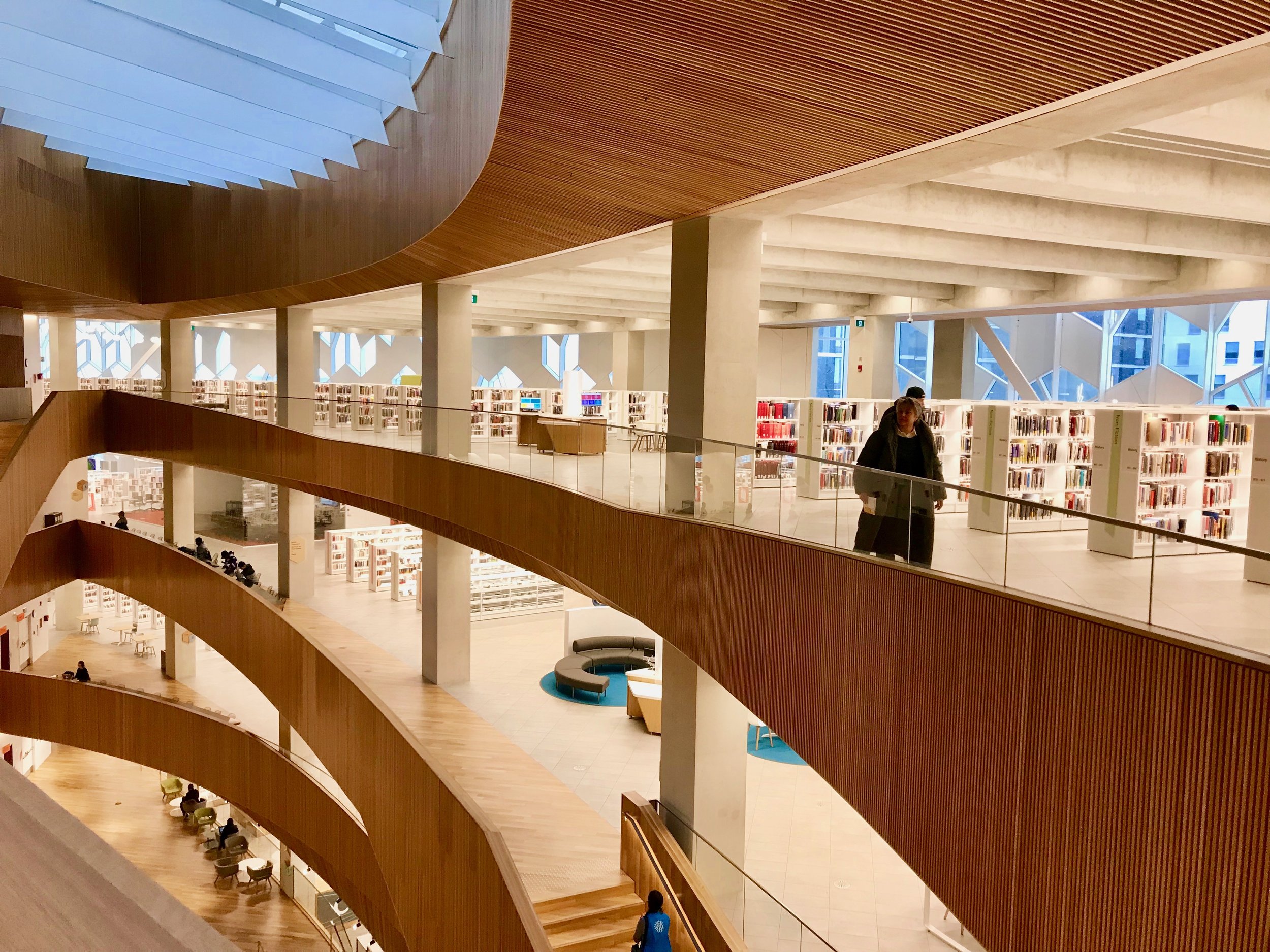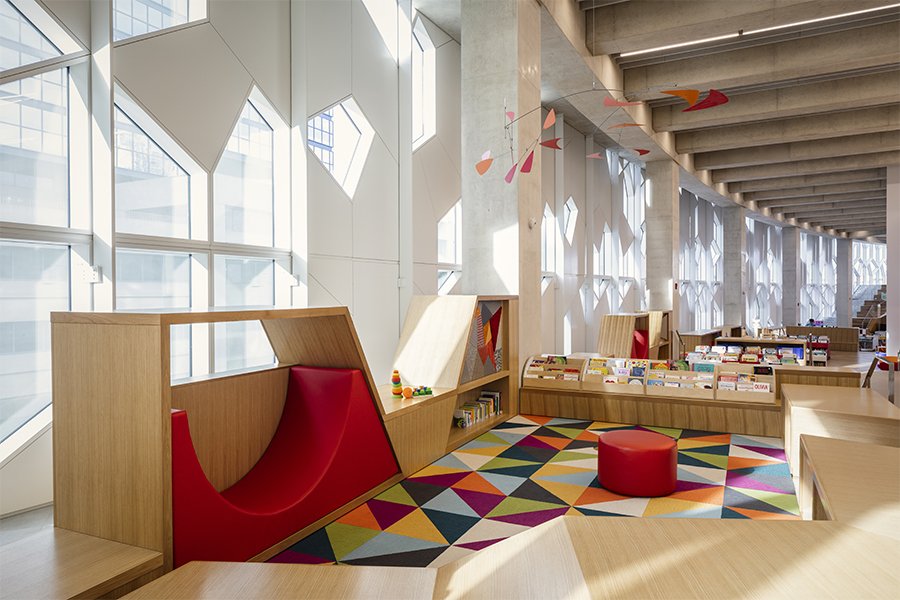Battle of Alberta: Calgary vs Edmonton’s Downtown Libraries
No matter how much architects, librarians, city planners and politicians might want to down play any comparison between Calgary and Edmonton’s downtown libraries, the public loves any opportunity for another “Battle of Alberta.”
Edmonton Central Library
Calgary Central Library
The Tank
On a recent trip to Edmonton, one of my “must sees,” was their renovated downtown library (Stanley A. Milner Library) nicknamed “The Tank.”
While some say, “you shouldn’t judge a book by its cover,” when it comes to architecture it is all about “first impressions.” And “The Tank” doesn’t make a great first impression.
It’s dull, military grey, angular, striated, zinc façade is simply not appealing to the eye/mind of most people, including me. And from a distance it does looks like a huge army tank, that is crushing the narrow glass entrance at street level. It creates a very aggressive first impression. It doesn’t help that the original computer renderings showed a façade with hundreds of windows and a silver, reflective façade that was more bright and cheerful.
Lesson NOT learned: Never over promise and under deliver, when it comes to architecture.
The angularity of Edmonton’s new library is in sharp contrast to the City’s other two contemporary iconic buildings the Art Gallery of Alberta and Rogers Place arena - both are curvaceous buildings with shinny metallic facades, that create positive first impressions with most Edmontonians and visitors.
Image on the left is the original computer rendering, while the image on the right is what was actually built.
The Curve
Calgary’s Central Library is the opposite of Edmonton’s library. Its gentle, curved, white and pastel coloured façade with hundreds of randomly places tiny angular shapes is playful and inviting from a distance.
Unfortunately, the building had to be raised high above the sidewalk (creating the need for a steep staircase or long ramp to get to the entrance) to allow for the LRT tunnel underneath. This means it has a less pedestrian friendly entrance than Edmonton’s entrance, which is at street level.
Photo credit: CMLC
The Lobby
Once inside, both libraries are dominated by uplifting atrium lobbies. Edmonton’s dramatic black and white atrium, with pops of colour, has support beams that ironically are like those that support the canopy of Calgary’s 7th Avenue LRT stations or Stephen Avenue’s white metal trees. The lobby includes a massive, multi-storey interactive video screen, dubbed “The Wall.” While we were there it was showing the artwork of Vincent Van Gogh, creating a colourful and welcoming second impression.
(Fun Fact: The Wall allows for hands-on learning as well as large-scale multimedia presentations, and is the biggest digital exhibit in North America, with 287 screens. It needs 12 computers to operate it.)
Edmonton’s Central Library’s lobby is black and white lobby with pops of colour.
Calgary’s entrance and lobby is unique in its use of wood - cedar for the outside entranceway and western hemlock for the inside ceiling and stairwell. The eye-shaped skylight is even more uplifting than Edmonton’s – it is celestial. The overall feel of the lobby is warm and cozy, like a huge family room.
The Art
Edmonton’s library has numerous smaller artworks strategically placed around the library to create cozy spaces where you can read next to your favourite piece of art – just like at home.
Peter von Tiesenhausen’s “Things I Knew To Be True”
There is one major piece - Peter von Tiesenhausen’s “Things I Knew To Be True,” but unfortunately it is very difficult to really look at, and can easily be missed.
It is installed on a third floor wall next to the staircase with dozens of hanging light fixtures in the way.
While it looks like lines of text from a book, you can’t really get close to see what it is. Frustrating for sure.
It was only after I got home and expanded my photos of the artwork on my computer that could see the 28 lines of what looked like text, are clusters of abstract figures.
Unfortunately, the subtleties of the artwork cannot really be appreciated given the placement of the piece in the library. In my opinion the wall is not really suited for any artwork.
Close up of Peter von Tiesenhausen’s “Things I Knew To Be True,” using camera to magnify.
One of dozens of artworks located in Edmonton’s Central Library.
Calgary’s Central Library does a much better job of integrating public art both inside and out. Christian Moeller’s “Trio” sculptures places two quirky, bobbing, plump, cartoon-like figures at the west (main entrance) and one at the east entrance to the to the library, create a wonderful sense of play even before you enter the library.
Moeller’s second installation “FISH” on the third floor next to a reading area, incorporates 10,000 books in 12 colours to create a three metres tall and 14 metres wide mural of a huge gold fish bowl, with a giant gold fish swimming towards you. It continues the building’s colourful and playful sense of place.
Calgary’s library is also home to three artworks by six indigenous artists.
A colourful mural in the library's main entrance, by Keegan Starlight, Kalum Teke Dan and Roland Rollinmud.
The buffalo sculpture, located on the stairs leading to the mezzanine level, by Lionel Peyachew.
A photo and text-based work, that will be part of the Elders' Guidance Circle on the library's fourth floor, by Glenna Cardinal and Brittney Bear Hat. The circle will be a space where people can meet with elders and join in Indigenous programming.
FISH, Christian Moeller, Calgary Central Library
Education is the New Buffalo, by Lionel Peyachew, welded steel, 2018 (photo credit: Zorica Gvozdenac)
Keegan Starlight, Kalum Teke Dan and Roland Rollinmud mural at the entrance to the Calgary Central Library. (photo credit: photo credit: Zorica Gvozdenac)
The Calgary Story section includes a tipi in recognition that the city’s history includes indigenous stories. (photo credit: photo credit: Zorica Gvozdenac)
The Services
Libraries today are no longer about being a warehouse for books, they are designed to be a community centres offering various educations programs to a diversity of citizens, as well as place to hang-out and/or make things. For many it is a safe place to be during the day.
The Edmonton Downtown Library features:
11,000-square-foot children's library with indoor playground, a giant floor piano (just like the one in the Tom Hanks movie Big) and a kids-only Makerspace offering coding, robotics and digital creation.
10,000-square-foot grown-up Makerspace with equipment for 3D printing, sound and video production.
1,336-square-foot gamers' area featuring everything from retro video games to today's newest consoles.
More than 70 public computers — more than double the original number.
150,000-plus items in the collection, including 10,000 new items.
As well, there is a new Indigenous gathering space, Thunderbird House, which is the first public space in Edmonton to support smudging. The floor, walls and ceiling are made from white poplar, believed to be the first tree in Treaty 6 territory.
2,100 square foot culinary centre provides educational programs relating to health, nutrition and food literacy.
The Muttart Theatre provides a multi-purpose space for reading, talks, concerts and performances.
Edmonton Central Library children’s area.
While an apple to apple comparison between the two library’s services isn’t possible, here are some of Calgary’s Central Library features:
There are 450,000 items in the Central Library collection, that are fully accessible. This includes books (180 tonnes of books), magazines, newspapers, DVDs, Blu-rays, CDs, Book CDs and microfilm.
On level four you will find Calgary’s Story collection. Whether you’re interested in learning more about the signing of Treaty 7, Calgary’s boom-and-bust past, exploring your house’s history, who Deerfoot Trail was named after, or what Calgary looked like at the turn of the century, you’ll find the answers in Calgary’s most accessible and browsable collection of community heritage and family history resources.
The 12,000 square foot children’s area is a fun place for children to explore with nooks available for families to play and read and even a nursing room for parents. It includes The Questionarium, a room where older kids learn and explore topics that change every few months.
There is a tipi in the middle of the library. It is on loan from Wolfchild Tipi and tents, a family-run business owned by Library employee Teneya Gwin’s parents.
TD Great Reading Room is a nod to the traditional of great libraries being a silent place to read and study. It is a wood-paneled room surrounded by special collections and a history of books exhibition, where a bibliophile can read or study to their heart’s content in peace and quiet.
A funky second level café offering great views of the LRT cars, entering and emerging from the tunnel underneath the building.
There is also a makers space, teen gaming centre, video and audio recording and editing rooms.
My favourite space in Calgary’s Central Library is the great reading room.
Calgary’s Central Library’s playful windows create light-filled spaces to read, study and chat.
Calgary Central Library children’s area.
The Site
Edmonton’s Downtown Public Library, nicely anchors the city’s downtown civic plaza (Churchill Square) which includes City Hall, Art Gallery of Alberta, Citadel Theatre and Winspear Centre. It is well connected to the Edmonton’s existing underground LRT line, as well as its new at grade 27-km Valley Line (Phase 1 expected open by March 2022). It also has direct access to underground parking, which is very convenient in the winter.
Unfortunately, Calgary’s new Central Library is hidden behind the City’s Municipal Building (which has a very similar massing as the library) and seems squeezed onto the site. Like, Edmonton there is easy access to the city’s downtown 7th Avenue Transit Corridor. What is unfortunate is Calgary’s library isn’t connected to the downtown’s extensive +15 elevated walkway system, which would have made it much more pedestrian friendly in the winter and provide easy access to the heated underground parkade across the street. It also isn’t well connected to Olympic Plaza (Calgary’s civic plaza) and the City’s other cultural icons – Arts Commons, Glenbow Museum and Stephen Avenue National Historic site.
Looking out from Edmonton Central Library to Churchill Square and City Hall (pyramid) and Art Gallery of Alberta (grey free formed building middle right) with transit in the foreground.
Calgary’s Central Library is not well connected to downtown’s Olympic Plaza - Calgary’s equivalent to Edmonton’s Churchill Square.
Last Word
Edmonton’s 230,000 square foot Central Library designed by Toronto’s Teeple Architects (with Stantec as the local architects) achieved a LEED Silver certification. Teeple’s previous work in Edmonton includes the Edmonton Police Service Northwest Campus and Clareview Community Recreation Centre & Branch Library.
Calgary Central library is a 240,000 square foot building, designed by Snohetta, an international firm that has designed libraries around the world, with local architects DIALOG. It achieved LEED gold certification.
The first impression of Calgary’s new downtown library is futuristic and playful, while Edmonton’s is stoic and sober, however, once inside both are bright and cheerful, offering a variety of services to citizens of all ages and backgrounds.
Edmonton’s renovated library cost $89M while Calgary’s new library cost $245M. Is three times better? I will let you be the judge.
If you like this blog, you will like these links:
Design Wars: It’s Edmonton vs Calgary for the architectural cup (CBC Calgary)
Calgary vs Edmonton: Who has the best river valley parks?
Edmonton vs Calgary: Urban Revival?

























